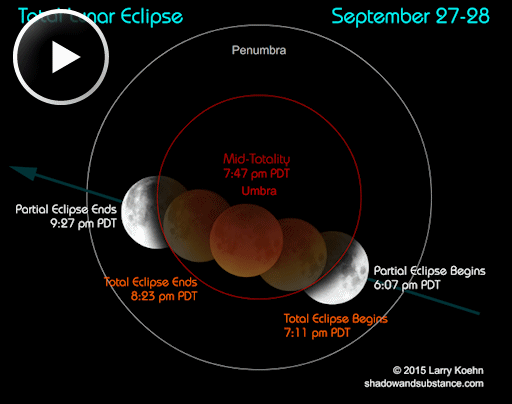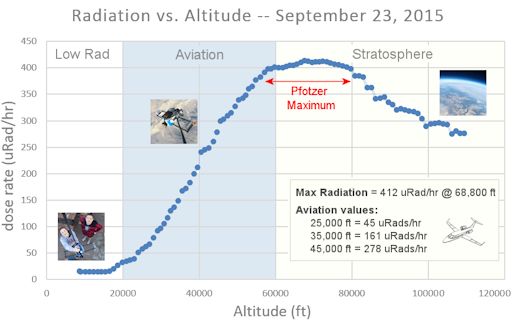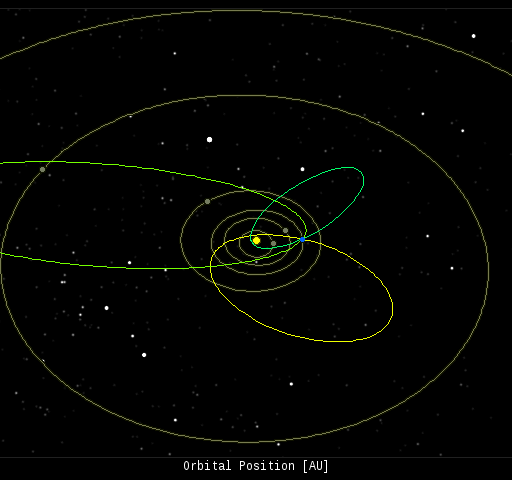On Sept. 27th, the Harvest Moon will pass through the shadow of Earth, turning the lunar disk a lovely shade of celestial red. Catch it live on the Internet, courtesy of the Coca-Cola Space Science Center in Columbus, Georgia. | | |
INCREASING CHANCE OF FLARES: Big sunspot AR2422 has developed an unstable 'beta-gamma-delta' magnetic field that harbors energy for strong solar flares. NOAA forecasters estimate a 40% chance of M-class solar flares and a 5% chance of X-flares on Sept. 27th. Because the sunspot is directly facing Earth, any eruptions this weekend will likely be geoeffective. Solar flare alerts: text or voice
SUPERMOON ECLIPSE: This weekend's full Moon is a supermoon, the biggest and brightest full Moon of the year. And it is going to be eclipsed. On Sunday evening, Sept. 27th, the supermoon will pass through the shadow of Earth, turning the lunar disk a coppery shade of red. Click on the image, below, to view an animation of the eclipse and to find out when to look:

Sky watchers in the Americas, Europe, Africa, and eastern parts of Asia can see the event. The next total eclipse of the Moon won't come until January 31, 2018, so if you live in the eclipse zone, check it out.
What makes the eclipsed Moon turn red? A quick trip to the Moon provides the answer: Imagine yourself standing on a dusty lunar plain looking up at the sky. Overhead hangs Earth, nightside down, completely hiding the sun behind it. The eclipse is underway.
You might expect Earth seen in this way to be utterly dark, but it's not. The rim of the planet looks like it is on fire. As you scan your eye around Earth's circumference, you're seeing every sunrise and every sunset in the world, all of them, all at once. This incredible light beams into the heart of Earth's shadow, filling it with a coppery glow and transforming the Moon into a great red orb.
Red isn't the only color. There's also turquoise, shown here in a photo taken by Jens Hackman during an eclipse in March of 2007:

Its source is ozone. Atmospheric scientist Richard Keen of the University of Colorado explains: "During a lunar eclipse, most of the light illuminating the moon passes through the stratosphere where it is reddened by scattering. However, light passing through the upper stratosphere penetrates the ozone layer, which absorbs red light and actually makes the passing light ray bluer." This can be seen, he says, as a soft blue fringe around the red core of Earth's shadow.
To catch the turquoise on Sept. 27-28, he advises, "look during the first and last minutes of totality. The turquoise rim is best seen in binoculars or a small telescope."
Realtime Eclipse Photo Gallery
COSMIC RAYS IN THE ATMOSPHERE: Once a week, and sometimes more often, Spaceweather.com and the students of Earth to Sky Calculus fly "space weather balloons" to the stratosphere. These balloons are equipped with radiation sensors that detect cosmic rays, a form of space weather important to people on Earth. Cosmic rays can alter the chemistry of the upper atmosphere, seed clouds, spark exotic forms of lightning, and penetrate commercial airplanes. This last point is of special interest to the traveling public. Our measurements show that someone flying back and forth across the continental USA, just once, can absorb as much ionizing radiation as 2 to 5 dental X-rays. From now on we will be present the results of our regular weekly balloon flights in a new and dedicated section of our web site: Cosmic Rays in the Atmosphere. Scroll down to find it.
As an example of the kind of data you'll see, here is a radiation profile from our Sept. 23rd flight:

As the balloon ascends toward the stratosphere, radiation levels increase rapidly. By the time the payload reaches aviation altitudes (25,000 ft to 45,000 ft), dose rates are as much as 50 times higher than sea level. According to the Sept. 23rd measurements, a plane flying at 45,000 feet is exposed to 278 uRads/hr. At that rate, a passenger would absorb about one dental X-ray's worth of radiation in 5 hours.
Radiation levels peak at the entrance to the stratosphere in a broad region called the "Pfotzer Maximum." This peak is named after physicist George Pfotzer who discovered it using balloons and Geiger tubes in the 1930s. Radiation levels there are nearly 100x sea level.
The radiation sensors onboard our helium balloons detect X-rays and gamma-rays in the energy range 10 keV to 20 MeV. These energies span the range of medical X-ray machines and airport security scanners, so the data are of practical interest to humans.
Realtime Space Weather Photo Gallery
Realtime Aurora Photo Gallery
Realtime Sprite Photo Gallery
| | Cosmic Rays in the Atmosphere |
| Situation Report -- Sept. 27, 2015 | Stratospheric Radiation (+37o N) |
| Cosmic ray levels are high. The trend is flat. Cosmic ray levels have increased +0% in the past month. |
| Sept. 06: 414 uRad/hr |
| Sept. 12: 409 uRad/hr |
| Sept. 23: 412 uRad/hr |
| Sept. 25: 416 uRad/hr |
These measurements are based on space weather balloon flights, described below. Introduction: Once a week, and sometimes more often, Spaceweather.com and the students of Earth to Sky Calculus fly "space weather balloons" to the stratosphere. These balloons are equipped with radiation sensors that detect cosmic rays, a form of space weather important to people on Earth. Cosmic rays can alter the chemistry of the upper atmosphere, seed clouds, spark exotic forms of lightning, and penetrate commercial airplanes. This last point is of special interest to the traveling public. Our measurements show that someone flying back and forth across the continental USA, just once, can absorb as much ionizing radiation as 2 to 5 dental X-rays. From now on we will be present the results of our regular weekly balloon flights in this section of our web site. Here is the radiation profile from our Sept. 23rd flight:

The radiation sensors onboard our helium balloons detect X-rays and gamma-rays in the energy range 10 keV to 20 MeV. These energies span the range of medical X-ray machines and airport security scanners. In the plot, dose rates are given in microRads per hour (uRads/hr). According to the Sept. 23rd measurements, a plane flying at 45,000 feet is exposed to 278 uRads/hr. At that rate, a passenger would absorb about one dental X-ray's worth of radiation in 5 hours.
Stay tuned for improvements to this section in the days and weeks ahead as we develop a glossary and better plain language strategies for communicating this information. Suggestions are welcomed.
Every night, a network of
NASA all-sky cameras scans the skies above the United States for meteoritic fireballs. Automated software maintained by NASA's Meteoroid Environment Office calculates their orbits, velocity, penetration depth in Earth's atmosphere and many other characteristics. Daily results are presented here on Spaceweather.com.
On Sep. 27, 2015, the network reported 3 fireballs.
(3 sporadics)

In this diagram of the inner solar system, all of the fireball orbits intersect at a single point--Earth. The orbits are color-coded by velocity, from slow (red) to fast (blue). [Larger image] [movies]
Potentially Hazardous Asteroids (
PHAs) are space rocks larger than approximately 100m that can come closer to Earth than 0.05 AU. None of the known PHAs is on a collision course with our planet, although astronomers are finding
new ones all the time.
On September 27, 2015 there were 1611 potentially hazardous asteroids.
Notes: LD means "Lunar Distance." 1 LD = 384,401 km, the distance between Earth and the Moon. 1 LD also equals 0.00256 AU. MAG is the visual magnitude of the asteroid on the date of closest approach. | | The official U.S. government space weather bureau |
| | The first place to look for information about sundogs, pillars, rainbows and related phenomena. |
| | Researchers call it a "Hubble for the sun." SDO is the most advanced solar observatory ever. |
| | 3D views of the sun from NASA's Solar and Terrestrial Relations Observatory |
| | Realtime and archival images of the Sun from SOHO. |
| | from the NOAA Space Environment Center |
| | the underlying science of space weather |
| | Web-based high school science course with free enrollment |

